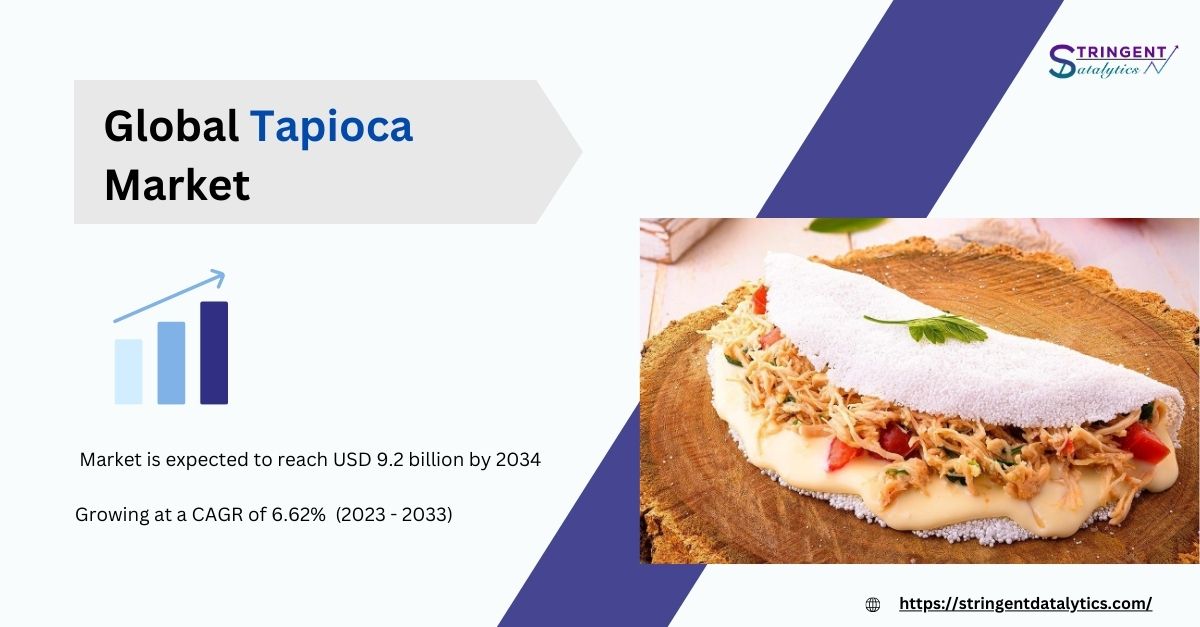Tapioca Market was valued at 4.55 billion in 2023 and is predicted to reach USD 9.2 billion by 2034, rising at a CAGR of 6.62% over the forecast period of 2024-2034.
The tapioca market refers to the global trade and consumption of tapioca, which is a starchy substance extracted from the roots of the cassava plant. Tapioca is a versatile ingredient used in various food products like puddings, pearls in bubble tea, flour, and as a thickening agent in soups and sauces. The market encompasses the production, distribution, and sale of tapioca products worldwide, influenced by factors such as consumer demand, agricultural trends, and economic conditions in tapioca-producing regions.
𝐀𝐜𝐜𝐞𝐬𝐬 𝐭𝐡𝐞 𝐅𝐫𝐞𝐞 𝐒𝐚𝐦𝐩𝐥𝐞 𝐑𝐞𝐩𝐨𝐫𝐭 𝐇𝐞𝐫𝐞: https://stringentdatalytics.com/sample-request/tapioca-market/14440/
Market Drivers:
- Rising Demand for Gluten-Free Products: With the growing awareness of gluten intolerance and celiac disease, consumers are increasingly opting for gluten-free alternatives, thus driving the demand for tapioca-based products.
- Expanding Food and Beverage Industry: Tapioca starch serves as a crucial ingredient in the food and beverage industry, contributing to the production of snacks, desserts, and beverages. The expanding food industry, coupled with the versatility of tapioca, is fueling market growth.
- Health Benefits: Tapioca is naturally low in cholesterol and fat, making it a healthier option compared to some other starches. Additionally, its resistant starch content offers digestive health benefits, further driving its consumption.
Market Restraints:
- Price Volatility: Tapioca production is influenced by factors such as weather conditions, which can lead to fluctuations in prices. This volatility poses a challenge for both producers and consumers in the market.
- Supply Chain Disruptions: The tapioca market is susceptible to supply chain disruptions, particularly in regions where cassava cultivation is prevalent. Factors such as transportation issues and political instability can impact the availability of tapioca products.
Market Segmentations:
Global Tapioca Market: By Company
Venus Starch
Grain Millers
Quality Starch & Chemical
Sonish Starch Technology
Vdelta
Varnica Herbs
Global Tapioca Market: By Type
Tapioca Animal Feed
Tapioca Flour
Tapioca Chips
Global Tapioca Market: By Application
Animal Feed
Food and Beverage
Industrial
Global Tapioca Market: Regional Analysis
The regional analysis of the global Tapioca market provides insights into the market’s performance across different regions of the world. The analysis is based on recent and future trends and includes market forecast for the prediction period. The countries covered in the regional analysis of the Tapioca market report are as follows:
North America: The North America region includes the U.S., Canada, and Mexico. The U.S. is the largest market for Tapioca in this region, followed by Canada and Mexico. The market growth in this region is primarily driven by the presence of key market players and the increasing demand for the product.
Europe: The Europe region includes Germany, France, U.K., Russia, Italy, Spain, Turkey, Netherlands, Switzerland, Belgium, and Rest of Europe. Germany is the largest market for Tapioca in this region, followed by the U.K. and France. The market growth in this region is driven by the increasing demand for the product in the automotive and aerospace sectors.
Asia-Pacific: The Asia-Pacific region includes Singapore, Malaysia, Australia, Thailand, Indonesia, Philippines, China, Japan, India, South Korea, and Rest of Asia-Pacific. China is the largest market for Tapioca in this region, followed by Japan and India. The market growth in this region is driven by the increasing adoption of the product in various end-use industries, such as automotive, aerospace, and construction.
Middle East and Africa: The Middle East and Africa region includes Saudi Arabia, U.A.E, South Africa, Egypt, Israel, and Rest of Middle East and Africa. The market growth in this region is driven by the increasing demand for the product in the aerospace and defense sectors.
South America: The South America region includes Argentina, Brazil, and Rest of South America. Brazil is the largest market for Tapioca in this region, followed by Argentina. The market growth in this region is primarily driven by the increasing demand for the product in the automotive sector.
Direct Report Purchase this Market Research: https://stringentdatalytics.com/purchase/tapioca-market/14440/?license=single
What are the Emerging Trends in the Global Market?
- Diversification of Tapioca Products: Tapioca is no longer confined to its traditional forms like pearls or flour. There’s a growing trend towards diversification, with tapioca being used in various innovative products such as tapioca chips, noodles, snacks, and even as a thickening agent in dairy alternatives and desserts.
- Gluten-Free and Allergen-Free Appeal: Tapioca’s natural gluten-free and allergen-free properties make it highly attractive to health-conscious consumers, particularly those with gluten intolerance or allergies. This trend is driving the use of tapioca flour in gluten-free baking mixes, bread, and other baked goods.
- Rise of Tapioca-based Alternatives: Tapioca is being increasingly used as a substitute for traditional ingredients like wheat flour or cornstarch in food products. This includes tapioca-based milk alternatives, tapioca starch-based coatings for fried foods, and tapioca-based thickeners in soups, sauces, and gravies.
- Sustainable Sourcing Practices: There’s a growing emphasis on sustainable sourcing of tapioca, driven by concerns about deforestation, land degradation, and social responsibility. Companies are investing in initiatives to promote responsible tapioca cultivation, including certifications for sustainable farming practices and support for smallholder farmers.
- Clean Label and Natural Ingredients: As consumers become more conscious of the ingredients in their food products, there’s a demand for clean label tapioca products with minimal additives and preservatives. Manufacturers are responding by offering tapioca-based products with simple, natural ingredients to meet this demand.
- Plant-based and Vegan Applications: Tapioca’s neutral flavor and versatile texture make it an ideal ingredient for plant-based and vegan food products. It is used in plant-based cheeses, yogurts, puddings, and other dairy alternatives, providing a creamy texture without the need for animal-derived ingredients.
- Innovation in Packaging and Processing: Technological advancements in processing techniques are enabling the development of new tapioca-based products with improved taste, texture, and nutritional profiles. Additionally, innovative packaging solutions are extending the shelf life of tapioca products and enhancing convenience for consumers.
- Global Culinary Exploration: Tapioca’s popularity is expanding beyond its traditional Asian markets, with chefs and food enthusiasts around the world experimenting with tapioca in various cuisines. This culinary exploration is driving demand for tapioca products and contributing to its growing presence in international markets.
Top Trending Report:
Global Dehydrated Onions Market
Global Functional Ingredients Market
Key Questions Explored in this Report:
- What is the current size and growth trajectory of the global tapioca market?
- What are the primary drivers influencing the demand for tapioca products worldwide?
- How does tapioca consumption vary across different regions and countries?
- What are the leading applications of tapioca in various industries such as food and beverages, animal feed, and industrial uses?
- Who are the major players operating in the tapioca market, and what are their strategies for growth and market penetration?
- What are the key challenges and constraints faced by tapioca producers and suppliers?
- How is the tapioca market responding to changing consumer preferences and dietary trends?
- What are the emerging opportunities and trends shaping the future of the tapioca industry?
About Stringent Datalytics
Stringent Datalytics offers both custom and syndicated market research reports. Custom market research reports are tailored to a specific client’s needs and requirements. These reports provide unique insights into a particular industry or market segment and can help businesses make informed decisions about their strategies and operations.
Syndicated market research reports, on the other hand, are pre-existing reports that are available for purchase by multiple clients. These reports are often produced on a regular basis, such as annually or quarterly, and cover a broad range of industries and market segments. Syndicated reports provide clients with insights into industry trends, market sizes, and competitive landscapes. By offering both custom and syndicated reports, Stringent Datalytics can provide clients with a range of market research solutions that can be customized to their specific needs.
Reach US
Stringent Datalytics
+1 346 666 6655
Social Channels:




Leave a Reply